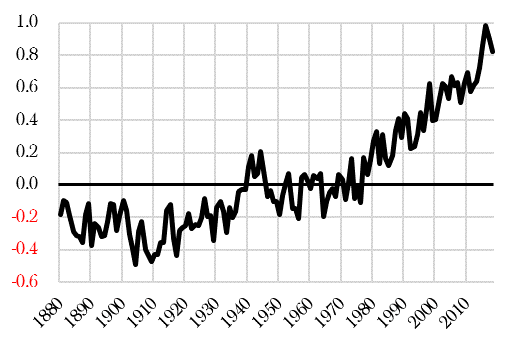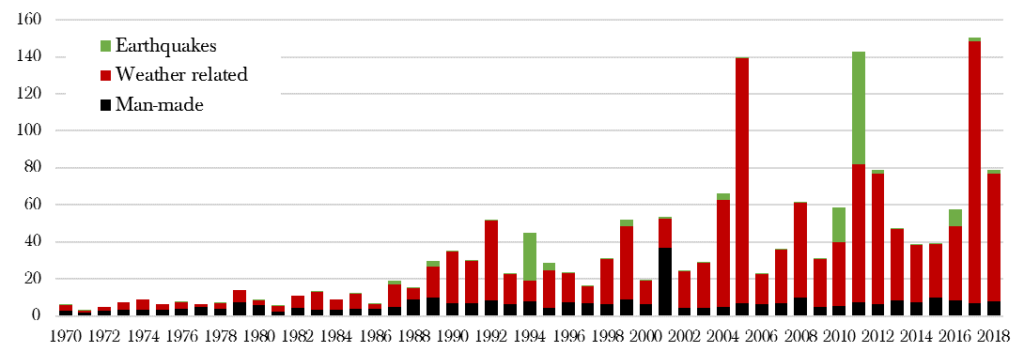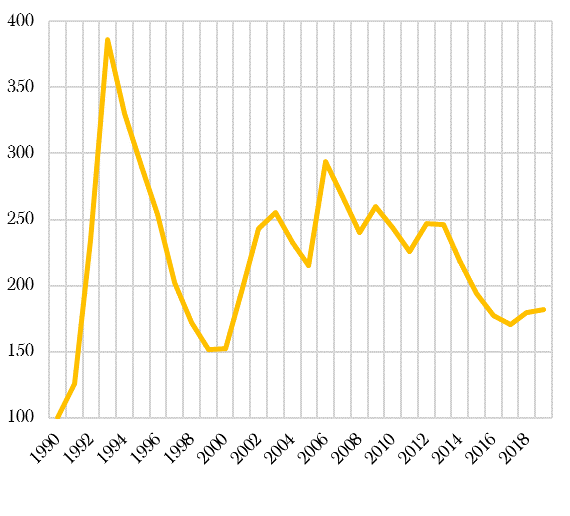
A World Transforming
Arguably the greatest challenge of long-term investment is to ignore the short-term. It is also a truism that investment newsletters are written an uncomfortably long time before they are delivered and read. It is therefore inevitable that much will have changed between typing these thoughts and their unruly disturbance of your Sunday cornflakes.
Our message for this spring is that no matter what has happened, or will happen, with you-know-what, tomorrow the sun will come up again. You-know-what is a short-term local issue with significantly less global importance than we may like to believe. The same is true of American interest rates.
No matter what the Federal Reserve does to the cost of borrowing, no matter whether the UK is in or out of the European Union, or even if we have decided that joining Asia is a better idea, each day brings a new and gradually warmer dawn. Summers are hotter, winters colder, storms more frequent and severe, fish fewer, farming more intense, antibiotics more prevalent, seas more polluted, dams more fragile, social intolerances and divisions deeper. Every day brings advances in artificial intelligence, bringing equal hopes of revolutionary medical breakthroughs and fears of a robotic, dehumanized and computer-ruled world.
The performances of financial markets in the first quarter of the year conveniently and beautifully illustrate some of the dangers of short-termism. Our last edition of Underneath the Arches tried to argue that the pessimism prevalent at the turn of the year was excessive and that there was much that could be done to prove the point. The past three months have duly turned out to be remarkably good and much of what was lost at the tail end of 2018 has been recouped.
No matter what has happened, or will happen, with you-know-what, the sun will come up again
Financial markets are becoming increasingly fickle. This current set of challenges began a year or so ago, when many investors started to become over-excited by the prospect of personal and corporate tax cuts in the United States. The result of that was an over-elevated position from which then to fret about a potential slowing of the global economy in the latter stages of last year. There was thus an over-reaction to the over-reaction, akin to watching a novice trying to correct the steering of a boat.
Time will tell whether or not the wholesome rises in the prices of both equities and bonds in the first quarter is an over-reaction to the over-reaction to the over-reaction. However, having started the year enthused by a number of the opportunities that we could see, both in the UK and overseas, we are again struggling to find assets that are obviously cheap.
Yields on bonds in particular have fallen to levels that are challenging. At the time of typing, the yield on the 10 year gilt is a miserly 1%. That though is positively generous compared to the opportunity in Germany, where the negative yield on the 10 year bund is again meaning that investors have the opportunity to pay the German government to look after their money safely until 2029. Both these yields are unhealthily and unsustainably low.
Of all the potential market scenarios for the remainder of the year, the least probable is that the ride will be smooth. This less than stunning conclusion is less a realization that there are many obstacles to overcome and likely mishaps, but much more a very simple reflection that sharp market moves beget more of the same. After a 15% rise in the S&P 500 in three months, a period of calm contemplation thereafter is most unlikely.
This is a revolution just as significant as its agrarian and industrial predecessors
Despite the notable failure of one country to play along we view the 2015 Paris Climate Change Agreement – COP 21 – as the most significant global development of a generation. The agreement to try to control temperature rise is determining profound changes to corporate and personal behaviour across the world. It is not only hastening the end of the world’s reliance on hydrocarbons, but is also the originating force behind the phenomenon of global sustainability, including the push back against single-use plastics. It is COP 21 and its focus on climate change that is driving (electrically of course) the demand for a better, more sustainable way of living. The scope of this is extraordinary: not just what we all know about plastics, or coal, or palm oil, but also issues like access to education, equal opportunity and non-discriminatory employment, safety in the workplace, reductions in food waste, rejection of child labour and human slavery and understanding of the side-effects of fast fashion.
It is a point that we made several times before, but this is a revolution just as significant as its agrarian and industrial predecessors. It is way beyond the development of new battery technology. Our cities and transport networks, for example, are designed to facilitate and support the use of privately owned vehicles. This will not last. I will be probably be looking up at the grass by the time this actually happens, but transport will become communally, or corporately, provided. Power will be primarily renewable and locally generated. The list is endless.
Equally, developments in technology will change much of what we currently understand. We are at the very beginning of the use of artificial intelligence, but the ability of software to learn will eventually transform almost everything that we do. We may all harbour suspicions: a headlamp that recognizes fog, for example, would seem to be a prerequisite for a self-driving car but is apparently currently beyond the world’s collective scientific ability.
It is a statement of almost no insight to say that many businesses will thrive and equally many will fail. Those most likely to fall into the former camp or those that understand, accept and embrace the opportunities ahead. Those that do not will wither. To understand this we need look no further than the high street. The era of routinely driving to an anodyne town centre shop is fading. Large retail businesses slow to grasp the change to on-line are falling all around us. Instead, they are being replaced not only by Amazon, but by a myriad of cyber shops. In turn, our town centres will have to change or become derelict. Local government funding in the UK, via business rates, is rooted in the dark ages and must be rethought.
By the time that we next interrupt your sustainable, fair trade coffee and gluten-free croissant we hope that many of the issues that we have deliberately avoided this quarter will be resolved. You-know-what, the trade wars, the path of American interest rates – all of these will become clearer. For what it may be worth, our best guesses are that Sino-US relations will be better and that the fed funds rate will stay very close to its current level for the remainder of this year. Markets will move on and find new worries.
2019 has started well, but has so far achieved no more than recoup what was lost at the end of 2018. Markets have become more volatile and random, in what we suspect is fatigue a decade after the end of the banking crisis. That should frame expectations for the remainder of the year, but it should not detract from the extraordinary opportunities – and risks – from a world transforming at a pace rarely seen.

Jim Wood-Smith – Chief Investment Officer, Private Clients
Riders on the Storm
Earth’s climate is changing (Chart 1). This is creating more erratic and extreme weather, a tangible financial risk for businesses and individuals: 2018 was the fourth most expensive year for insured catastrophe losses, and 2017/18 was the worst ever two-year period (Chart 2). At the battlefront of climate risk is the catastrophe insurance sector. Its greatest challenge is to price accurately that risk in an increasingly volatile world.
Chart 1: Global surface temperature anomaly, annual mean

Source: GISS Surface Temperature Analysis, NASA
Known Unknowns
The climate is a notoriously difficult thing to predict, not least because we have no experience of a planet with average temperatures so high: we are in uncharted (warmer) waters (Chart 1). Studies conclude, however, that warmer sea temperatures and higher sea levels create hurricanes with maximum wind speeds up to 11% faster and with on average 20% more precipitation (Source: GFDL). Faster winds and more aggressive downpours will generally mean far greater damage to property during hurricane season.
The frequency of hurricanes is also on the rise. In the North Atlantic Basin, the long-term (1966-2009) average number of tropical storms is 11 annually, with 6 becoming hurricanes. More recently (2000-2013), the average is 16 tropical storms per year, including 8 hurricanes.
Chart 2: Global insured losses since 1970 (billion USD, inflation-adjusted to 2018 prices)

Source: Swiss Re Institute
It is beyond the scope of this paper to lament society’s sluggishness on climate risks, yet for insurers with capital on the line its implications are more urgent. Catastrophe modelling is a specialism that began in earnest after 1992’s Hurricane Andrew caused $15.5bn of insured losses and 13 insurer liquidations. Whilst models previously relied on databases of past events, climate change means the next decade’s weather probably won’t just be a rerun of the past.
Insurers therefore today employ teams of climate scientists to create highly complex forecasting models. The challenge is the added uncertainty: small assumption changes may increase hurricane severity, yet might also divert their usual paths. A 2015 MIT study, for example, found a rising chance of a hurricane entering the Persian Gulf, home to a wealth of oil assets. Added uncertainty necessarily means higher premiums; there is a chance that property in coastal regions becomes too expensive to insure at all.
The Insurance Cycle
A major catastrophe forces insurers to pay out large claims (as with Hurricane Andrew, sometimes to the extent under-capitalized insurers go bust). The result is less capital at a time when people are anxious to ensure they are insured, which pushes up prices. Highly profitable insurance can be written and, should this continue in a relatively low claims environment, capital is lured back in by the high returns. Competition means prices fall, potentially to uneconomic levels. Then a catastrophe occurs and the cycle starts again.
The irony therefore is that well-capitalized insurers welcome periods of higher claims since it wipes out excess capital and leads to better returns. After all, were there no catastrophes, there would be no catastrophe insurance industry.
Cat bonds and the hunt for yield
At least, that’s the way the cycle is supposed to work. More recently, the insurance cycle appears broken: despite the single worst two-year period for claims ever, renewal prices for catastrophe insurance have barely flinched (Chart 3). Prices do not seem to be factoring in what we know about how uncertain and extreme weather has become.
One explanation is a flood of new capital from catastrophe bonds and insurance-linked securities. Cat bonds are high-yield debt instruments that enable the issuer to waive payment of interest (or even principal) if it suffers a predefined catastrophe loss. These securities were formed in response to the prolonged period of low yields on traditional assets, coupled with a desire to find investments that are uncorrelated to equity markets.
At the end of 2018, insurance-linked securities amounted to almost $100bn of additional capital, a five-fold increase in the last decade. The worry is that the ‘hunt for yield’ is compressing prices right at the time when prices are inadequately allowing for climate change-related risks.
Chart 3: Global Property Catastrophe Rate-On-Line Index

Source: Guy Carpenter & Company LLC
The caveat is that one must distinguish between reinsurance and speciality lines. Reinsurance (insurance for insurance companies) is more capital intensive and increasingly commoditized. It is into these areas that the capital from cat bonds can effortlessly flow. Speciality insurance is more difficult for capital to access since it is typically smaller ticket, bespoke and requires a franchise and distribution network. Our strong preference in the current environment is to invest into the specialists, not the reinsurers.
Summary
Changes to our climate mean that we are living in a world with more volatile weather. For the insurance industry, this is not necessarily a bad thing: greater uncertainty and risk implies a greater need for the industry’s services. Ironically, insurers may be the surprise beneficiaries of climate change.
That, however, is only true to a point: insurers need to be able to assess the likelihood of various loss events to set profitable insurance rates. The greatest challenge for insurers is doing so in an increasingly unpredictable world.
Moreover, there is nothing in current rates to suggest the industry has yet updated its expectations for heightened climate risks, exacerbated perhaps by new capital sources. Every insurer insists that they carefully manage the cycle for returns, though history suggests most will still fail to write less business when pricing is poor.
Investors in reinsurance shares face stubbornly weak rates, prospects of the most extreme weather in modern human history and relatively expensive share prices. This is not a recipe for an adequate ‘margin of safety’. Regrettably, it may take an unimaginably large loss event to reset premiums, share prices and expectations in this changed world.
 Ian Woolley CFA – Senior Investment Analyst
Ian Woolley CFA – Senior Investment Analyst
This document is issued by Hawksmoor Investment Management Limited (“Hawksmoor”) whose registered office is at 2nd Floor Stratus House, Emperor Way, Exeter Business Park, Exeter, Devon EX1 3QS. Company No. 6307442. This document does not constitute an offer or invitation to any person in respect of any investments described, nor should its content be interpreted as investment or tax advice for which, if you are an individual, you should consult your independent financial adviser and or accountant. The information and opinions it contains have been compiled or arrived at from sources believed to be reliable at the time and are given in good faith, but no representation is made as to their accuracy, completeness or correctness. Hawksmoor, its directors, officers, employees and their associates may have a holding in any investments described. Any opinion expressed in this document, whether in general or both on the performance of individual securities and in a wider economic context, represents the views of Hawksmoor at the time of preparation. They are subject to change. Past performance is not a guide to future performance. The value of an investment and any income from it can fall as well as rise as a result of market and currency fluctuations. You may not get back the amount you originally invested. With regard to any of the Hawksmoor’s managed Funds, please read the prospectus and Key Investor Information Document (“KIID”) before making an investment.
